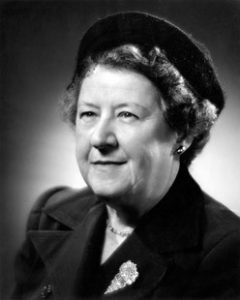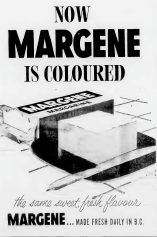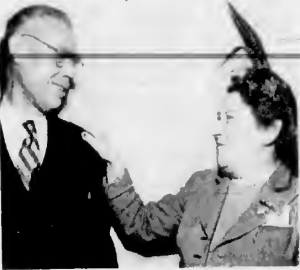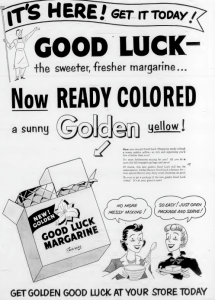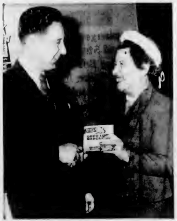Tilly Rolston and Coloured Margarine
I noticed the comment “Mrs. Tilly J. Rolston, “The Champion of Coloured Margarine” on the back of an archived pamphlet describing BC Social Credit election candidates from the early 1950’s and I was immediately intrigued[i]. Who was this woman? For International Women’s Day, I decided to see what I could find out about Tilly Rolston and her connection to coloured margarine.
Tilly Rolston was born in Vancouver, British Columbia in 1887. Following her studies at the Vancouver Provincial Normal School and the University of British Columbia, she worked as a teacher and later as a homemaker and Sunday school teacher. She was also involved with numerous community associations such as the Vancouver Council of Women. She held a leadership role as a Director of the Pacific National Exhibition in Vancouver and was elected to the Parks Board in 1938. She is described as a political veteran, who entered the provincial political arena at the age of 54, winning election to the Legislative Assembly in 1941 as the Conservative member for the riding of Vancouver-Point Grey. She was re-elected in 1945 and 1949 as a Liberal-Conservative coalition member and, in 1952, as a member of the first Social Credit Party government. It is suggested that she and W.A.C. Bennett added both colour and respectability when they joined the Social Credit Party. Reynolds (1952) in an article about how the Socreds won the 1952 election described her thus:
Among the Cromwellian-shaded Social Crediters, Tilly, an ebullient grandmother, stood out like a red sail. She liked a cocktail, smoked (and once set fire to her hat while lighting a cigarette at a civic meeting) , administered her Vancouver home according to the tenets of an Esquire Handbook for Hosts, loved bridge, costume jewelry and making annual tours to just about every part of the world except Alberta.[ii]
Premier W.A. C. Bennett named Rolston Minister of Education making her the first cabinet minister in Canada with a portfolio. Sadly, Rolston died of cancer in October of 1953. She was the first woman in British Columbia to be given a state funeral.[iii]
During her time as an MLA, she served for several years as Chair of the Select Standing Committee on Social Welfare. At the House’s direction, the Committee studied and made recommendations on such topics as unemployment, drug addiction and old age and mothers’ pensions. As Minister of Education she introduced a new school funding formula, known as the Rolston Formula, that transferred some of the financial burden from the municipal to the provincial level. She was charged with implementing a controversial school curriculum guide entitled Effective Living (1952) that included references to teen-age dating and was deemed by some to be sex education[iv].
But what made her a public favorite was waging and winning a stubborn fight to make coloured margarine legal in B. C.
Margarine was invented by a Paris chemist, Hippolyte Mège-Mouries, in response to a contest announced by Napoleon III in 1866 for a suitable, inexpensive substitute for butter. The invention was named margarine and it began to spread throughout the world. In Canada the dairy industry perceived margarine as a threat and argued that a ban on margarine was necessary to protect the public against the deceptive product.
In 1886, the Federal government passed the Act to Prohibit the Manufacture and Sale of Certain Substitutes for Butter which outlawed margarine. This act transformed into the 1903 Butter Act which prohibited the manufacture, import or sale of oleomargarine or other substitutes for butter. In turn, the Butter Act was rolled into the Dairy Act 1914, that maintained the prohibition of “any oleomargarine, margarine, butterine, or other substitute for butter, manufactured wholly or in part from any fat other than that of milk or cream.”[v] The ban was temporarily lifted during World War I to help with dairy shortages during the war.
After World War II, the federal ban on margarine in Canada was struck down by the courts in 1948 and regulation became a provincial responsibility. Provincial governments quickly moved to protect consumers who might become confused between margarine and butter by regulating its colour. In some provinces, margarine had to be bright yellow. In others, it was sold colourless. Some margarines were sold in a plastic sack that came with a tab. Pressing the tab released a yellow dye into the margarine. Squishing the sack for 20 minutes or so would mix the dye into the margarine[vi].
The first margarine to be sold anywhere in Canada was made by Associated Producers and sold in Burnaby, BC, in December 21, 1948[vii]. The Department of Agriculture reported that five licences to manufacture margarine and 24 licences to wholesalers of margarine were issued that year.[viii]
In 1948 the BC Standing Committee on Agriculture had several meetings with the Advisory Board of the Farmers Institutes and representatives from the BC Federation of Agriculture, and recommended “that if margarine is allowed, no colour representing butter be permitted whenever sold or served, nor any advertising be allowed that suggests farming” (p. 41).[ix] “The legislature gave its approval Wednesday [1948] to the margarine measure which specifies the amount of yellow colouring allowed in it, requires clear labelling that it is not butter and makes restaurants inform the public when they are serving it instead of butter,” the Province reported[x].
And that’s where Tilly’s story begins. The Oleomargarine Act set the stage for a two year fight by Rolston to remove the colour restrictions. She fought for choosing a palatable colour for margarine by challenging the bill that limited the colour to an ivory white shade[xi]. She was joined in the fight by “Penny Wise” the 1950s Vancouver Sun columnist who was actually reporter Evelyn Caldwell. Evelyn called her fans the FFFers, for Feminine Fighting Force, and frequently engaged them in letter-writing campaigns to change consumer laws. She was able to collect 1500 letters from her FFFers in a week and a half[xii] to protest the ban on coloured margarine.
In March 1951, Rolston made a motion in the BC Legislature that the prices of butter had become prohibitive and the colour restrictions should be removed. This motion was defeated but she didn’t give up. She continued to campaign and in 1952 a bill was passed that ended all colour regulations for margarine. The new regulations were described in the Department of Agriculture 952 Report:
The only agricultural legislation dealt with at the Second Session of the Twenty-third Parliament of British Columbia was an Act to amend the ” Oleomargarine Act,” being chapter 48 of the Statutes of 1949, and cited as the ” Oleomargarine Act Amendment Act, 1952.” Of the various changes as introduced in this Bill, the most important was the repeal of section 5 of the 1949 Statute, which read as follows: ” Colouring of ‘oleomargarine’:No oleomargarine shall have a tint or shade containing more than one and six-tenths degrees of yellow, or of yellow and red collectively, measured in terms of the Lovibond tintometer scale read under conditions substantially similar to those established by the United States Bureau of Internal Revenue, or the equivalent of such measurement.” The result of this amendment was that oleomargarine could be coloured the same as butter.[xiii]
The Daily Colonist (March 27, 1952, front page) reported:
The end of the fourth session of the 22nd Legislature yesterday brought big victory for Mrs. Tilly Rolston, Independent M.L.A. from Vancouver-Point Grey. Just before prorogation, Lieutenant-Governor Clarence Wallace gave Royal Assent to her bill to permit factory colour of margarine. Chief opponent of colour throughout the session has been Alex Hope (P.C. Delta) spokesman for Fraser Valley cattlemen. Mr. Hope, a good loser, congratulates Mrs. Rolston on her success[xiv].
Losing no time, advertising for the new margarine appeared the day after the new law was passed in the Daily Colonist:
And on page13 there is another picture of Tilly with this caption:
Happiness and success in a long Legislative battle is registered by Mrs. Tilly Rolston (right) as independent representative for Vancouver- Point Grey gets her first pound of ready-coloured Good Luck Margarine from F. P. Steele, Pacific regional manager for Lever Bros. Ltd. Colored margarine went on sale in Victoria today following signature of the bill, sponsored by Mrs. Rolston, which removes restrictions on the sale of colored product. A similar bill introduced by Mrs. Rolston last spring was shelved after second reading.
In 1973, legislation was passed to end the requirement to have public eating places and margarine wrappers refer to margarine as a “substitute for butter”. Tilly Rolston’s grandson, and MLA at the time was happy to see fruition his family’s twenty-five year crusade (Heick, 1991, p. 113).
Margarine is an example of how the history of a food can “speak to the slippery intersection between society, law and the lobbyist” [xv]. According to Heick (1991), Tilly Rolston and her crusade for coloured margarine is part of “BC’s reputation for colourful people and history”( Heick, 1991,p. 102). I definitely agree.
[i] Mackie, J. (2017, March 21). Archived pamphlets and photos show BC Socreds knew how to brag. The Vancouver Sun. https://vancouversun.com/news/local-news/archived-pamphlets-and-photos-show-b-c-socreds-knew-how-to-brag
[ii] Reynolds, Mac (1952, September 1). How Social Credit Took B.C. Macleans, pp. 55-56. https://archive.macleans.ca/article/1952/9/1/how-social-credit-took-bc
[iii] 100 Years of women and the vote. Tilly Rolston, the first woman Canada to be appointed a cabinet minister with portfolio (1952). Legislative Assembly of British Columbia. https://www.leg.bc.ca/wotv/pages/featured-women/tilly-rolston.aspx
[iv] https://s.web.viu.ca/homeroom/content/topics/people/rolston.htm
[v] Elliott, C. (2009). Canada’s Great Butter Caper: On Law, Fakes and the Biography of Margarine. Food, Culture & Society, 12(3), 379-396; Heick, W. H. (1991). A propensity to protect: butter, margarine and the rise of urban culture in Canada. Wilfrid Laurier Univ. Press.
[1] Resolving Canada’s conflicted relationship with margarine (2008, July 9). CBC News · https://www.cbc.ca/news/technology/resolving-canada-s-conflicted-relationship-with-margarine-1.741363
[vii] Heick, W. H. (1991). A propensity to protect: butter, margarine and the rise of urban culture in Canada. Wilfrid Laurier Univ. Press p. 91. https://www.cooksinfo.com/canadian-food/
[viii] Province of British Columbia (1949). Report of the Department of Agriculture 1948, Victoria, Kings Printer.
[ix] Province of British Columbia (1949). Report of the Department of Agriculture 1948, Victoria, Kings Printer.
[x] Donaldson, J. (2004, Aug. 2). Five Bizarre Stories about BC’s past. TheTyee. https://thetyee.ca/Culture/2014/08/02/Bizarre-History-BC/
[xi] http://www.vancouverhistory.ca/chronology1949.htm
[xii] Newswomen gain ground in 1950s (2012, September 21). Vancouver Sun http://www.vancouversun.com/Newswomen+gain+ground+1950s/7280806/story.html
[xiii] Province of British Columbia (1953). Department of Agriculture Forty- seventh Annual Report 1952. Victoria: Queen’s Printer. pp. 15-16
[xiv] Session Ends sees Success, Failure and Retirement (1952, March 27) The Daily Colonist, p, 1. Victoria BC http://archive.org/stream/dailycolonist0352uvic_21#page/n11/mode/1up/search/margarine+tilly
[xv] If you are interested in further reading on the general story of margarine in Canada, I recommend:
Ball, R. A., & Lilly, J. R. (1982). The menace of margarine: the rise and fall of a social problem. Social Problems, 29(5), 488-498.
Dupré, R. (1999). “If It’s Yellow, It Must Be Butter”: Margarine Regulation in North America Since 1886. The Journal of Economic History, 59(2), 353-371.
Elliott, C. (2009). Canada’s Great Butter Caper: On Law, Fakes and the Biography of Margarine. Food, Culture & Society, 12(3), 379-396.
Heick, W. H. (1991). A propensity to protect: butter, margarine and the rise of urban culture in Canada. Wilfrid Laurier Univ. Press.
Sadovnikova, A., Mikhailitchenko, A., & Shapiro, S. J. (2014). Consumer protection in postwar Canada: role and contributions of the Consumers’ Association of Canada to the public policy process. Journal of Consumer Affairs, 48(2), 380-402.
Smith, T. M., & Jukes, D. J. (1997). Food control systems in Canada. Critical Reviews in Food Science & Nutrition, 37(3), 229-251.

